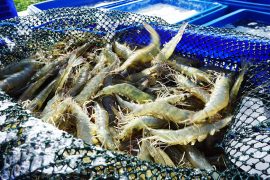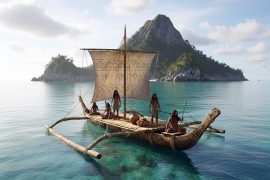
Is there really life beyond Earth? AI could soon solve this mystery
New research led by Dr. Jim Cleaves and Dr. Robert Hazen may soon provide answers to our questions about the existence of life beyond our planet.
A team from the Carnegie Institution for Science has devised a test that harnesses the power of artificial intelligence (AI) to detect signs of past or present life on other celestial bodies.
Incredible accuracy
The AI-based method can differentiate between biological samples from the ancient and modern era and those of non-biological origin with 90 percent accuracy.
Dr. Hazen believes that this “routine analytical method” will revolutionize the search for life beyond Earth. Not only does it shed light on the earliest life forms on our planet, but it also paves the way for robotic spacecraft, landers, and rovers to scout for life on distant planets and moons.
Study significance
One immediate application of this test could be on the samples already collected by NASA’s Mars Curiosity rover. While some adjustments to align with SAM’s (Sample Analysis at Mars) protocols are necessary, it might soon be possible to discern if organic molecules on Mars are remnants of a Martian biosphere.
Dr. Cleaves emphasized the profound implications of this discovery. At its core, this research confirms that there are inherent differences between biochemistry and abiotic organic chemistry.
Additionally, it provides a novel tool to verify the liveliness of samples from ancient Earth and Mars.
More importantly, the technology could potentially recognize life forms different from those we’re familiar with on Earth, which is crucial for future astrobiology missions.
Breakthrough approach
Unlike previous tests that target specific molecules or compound groups, the innovative method uses AI to identify nuanced differences in molecular patterns. These patterns emerge from a pyrolysis gas chromatography analysis followed by mass spectrometry.
During their research, the team used multidimensional data from 134 biotic or abiotic carbon-rich samples to train the AI.
The experts found that AI could determine whether samples were derived from living organisms, remnants of ancient life, or purely abiotic sources with a success rate of 90 percent.
Ancient samples
An important note from the research team is that the origins of numerous ancient carbon-bearing samples remained ambiguous until now.
Over time, both biotic and abiotic organic molecules degrade, making their origins tough to trace. However, this technique, even with decay and alteration, was able to detect signs of biological presence from samples as old as hundreds of millions of years.
The chemistry of life
“We began with the idea that the chemistry of life differs fundamentally from that of the inanimate world; that there are ‘chemical rules of life’ that influence the diversity and distribution of biomolecules,” said Dr. Hazen.
“If we could deduce those rules, we can use them to guide our efforts to model life’s origins or to detect subtle signs of life on other worlds.”
“These results mean that we may be able to find a lifeform from another planet, another biosphere, even if it is very different from the life we know on Earth. And, if we do find signs of life elsewhere, we can tell if life on Earth and other planets derived from a common or different origin.”
“Put another way, the method should be able to detect alien biochemistries, as well as Earth life. That is a big deal because it’s relatively easy to spot the molecular biomarkers of Earth life, but we cannot assume that alien life will use DNA, amino acids, etc. Our method looks for patterns in molecular distributions that arise from life’s demand for “functional” molecules.”
“What really astonished us was that we trained our machine-learning model to predict only two sample types – biotic or abiotic – but the method discovered three distinct populations: abiotic, living biotic, and fossil biotic. In other words, it could tell more recent biological samples from fossil samples – a newly plucked leaf or vegetable, say, versus something that died long ago,” noted Dr. Hazen.
“This surprising finding gives us optimism that other attributes such as photosynthetic life or eukaryotes (cells with a nucleus) might also be distinguished.”
Biotic and abiotic samples
“From a chemical standpoint, the differences between biotic and abiotic samples relate to things like water solubility, molecular weights, volatility and so on,” said Dr. Cleaves.
“The simple way I would think about this is that a cell has a membrane and an interior, called the cytosol; the membrane is pretty water-insoluble, while the cell’s content is pretty water-soluble. That arrangement keeps the membrane assembled as it tries to minimize its components’ contacts with water and also keeps the ‘inside components’ from leaking across the membrane.”
“The inside components can also stay dissolved in water despite being extremely large molecules like chromosomes and proteins,” he says.
“So, if one breaks a living cell or tissue into its components, one gets a mix of very water-soluble molecules and very water-insoluble molecules spread across a spectrum. Things like petroleum and coal have lost most of the water-soluble material over their long histories.”
“Abiological samples can have unique distributions across this spectrum relative to each other, but they are also distinct from the biological distributions.”
Solving mysteries
With this advancement, several scientific enigmas, such as the origins of the 3.5 billion-year-old black sediments from Western Australia, may soon be resolved.
These rocks, which are a subject of debate among scientists regarding their potential to contain Earth’s oldest fossil microbes, might finally give up their secrets.
“We’re applying our methods right now to address these long-standing questions about the biogenicity of the organic material in these rocks,” said Dr. Hazen.
“If AI can easily distinguish biotic from abiotic, as well as modern from ancient life, then what other insights might we gain? For example, could we tease out whether an ancient fossil cell had a nucleus, or was photosynthetic?”
“Could it analyze charred remains and discriminate different kinds of wood from an archeological site? It’s as if we are just dipping our toes in the water of a vast ocean of possibilities.”
The research is published in the Proceedings of the National Academy of Sciences, and was financially backed by the John Templeton Foundation.
Like what you read? Subscribe to our newsletter for engaging articles, exclusive content, and the latest updates.
—-
Check us out on EarthSnap, a free app brought to you by Eric Ralls and Earth.com.













